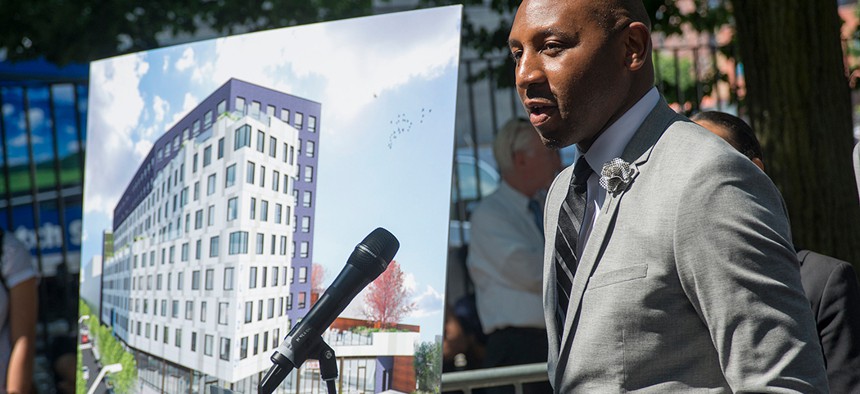New York City
Why AMI are the three most controversial letters in New York housing policy
An explainer on New York City's area median income, and what it means for affordable housing.

New York City Councilman Donovan Richards announces over 200 units of affordable housing - along with new retail and community space in Far Rockaway. Jeff Reed for the New York City Council
With the controversial rezoning of Inwood, a neighborhood at Manhattan’s northern tip, having just passed the City Council, some New York City low-income housing advocates have questioned whether Mayor Bill de Blasio’s approach to affordable housing is working.
A frequent activist complaint about plans to upzone and allow more market-rate housing development in low-income neighborhoods is that much of the affordable housing in new buildings is targeted at income bands as high as 165 percent of the area median income (AMI) – meaning that it goes to middle-class or even upper-middle class households.
That AMI figure is even higher because it is calculated by the U.S. Department of Housing and Urban Development, rather than the city, and it includes the whole metropolitan region. New York City’s AMI is inflated by the inclusion of income data from affluent suburbs, meaning what the city may designate as affordable housing may not be affordable for many city residents – and especially not for the residents of the neighborhood itself.
Here is how it works and could be changed:
How is AMI calculated in NYC?
The region’s AMI includes the median income from Westchester, Rockland and Putnam counties, which all have higher median incomes than the five boroughs. According to the U.S. Census, Putnam County’s median household income from 2012-2016 was $97,606 while Manhattan, the borough with the highest median income, had one of $75,513. This means that what HUD determines AMI to be is inflated by data from counties far beyond New York City and possibly several hours’ drive from any given new development.
Interestingly, both Westchester and Rockland do not include New York City’s income in determining their AMI because of legislation passed in Congress in the 1990s.
How big are the discrepancies between AMI and actual median incomes in New York City itself?
In 2015, AMI in New York for a family of three was $77,700. That’s higher than it would be for any of the five boroughs individually. The median household income in Manhattan from 2012-2016 was $75,513, while the Bronx had the lowest median household income at $35,302 over the same time frame. Brooklyn, Queens and Staten Island were $50,640, $59,758 and $74,021, respectively. According to a calculation in a 2011 report produced by the Association for Neighborhood and Housing Development, in 2010 HUD’s New York-area AMI for a family of four was 20 percent higher than the actual median for such a family in New York City proper.
How are affordable housing projects affected by the AMI?
The New York City Department of Housing Preservation and Development uses AMI to determine income requirements for affordable units and what rents landlords can charge for those units. Because New York’s AMI is inflated, this means units that may be designated as affordable may not be affordable to most renters from the community. East New York, a recently rezoned neighborhood in Brooklyn, provides a stark example – more than one-third of families in East New York earn less than 30 percent AMI.
The AMI for households or different sizes can be found here.
Why doesn’t New York City change the way AMI is calculated?
HUD, which draws its regions based on information from the U.S. Office of Management and Budget, has no formal mechanism for cities or counties to challenge an AMI. A HUD official has previously indicated that such a change would require an act of Congress.
That has not stopped the state Legislature from pursuing their own means of determining AMI. State Sen. Michael Gianaris and Assemblyman Brian Barnwell sponsored legislation last year that would require affordable housing developers to calculate AMI based on the zip code they are building in.
However, some have also argued that New York City’s current means of calculation makes affordable housing development more financially viable than it would be developers had to charge lower rents based on a lower AMI. This argument is similar to the justification for Westchester getting its AMI calculated separately in 1990. The rent paid by residents in Westchester affordable housing was too low cover operating costs, according to landlords, as New York City’s income was dragging its AMI down.
Of course, if New York City used a city-only or zip code-only AMI, it could still make some of the apartments more expensive and aimed at higher-income renters – it just would be more transparent.
NEXT STORY: 5 things to know about the Inwood rezoning

